
- Inspire – Upper Airway Stimulation and Sleep Apnea - September 25, 2017
- Treatment of Recurrent Respiratory Papillomatosis - September 25, 2017
- India Medical Mission 2018 - November 1, 2018
- Sleep Disorders: Sleep Apnea and Upper Stimulation Therapy - August 25, 2015
- The Naked Vocalist Podcast Featuring Dr. Reena Gupta - May 27, 2015
- New Therapy for Sleep Apnea – First Sleep Pacemaker placed in California at Osborne Head and Neck Institute. - December 12, 2014
- Boxer’s Ear: Can your ear explode? - December 12, 2014
- Nose Picking (Rhinotillexis) and Septal Perforations: Why I should stop picking my nose…? - November 24, 2014
- Deviated Septum and Septal Perforation - July 28, 2014
- Hereditary Hemorrhagic Telangiectasia: Nasal Septal Perforation Repair - June 25, 2014
- Dr. Mantle recognized at the Beverly Hills Medical Science Academy Awards - May 8, 2014
- Commonly Misdiagnosed Pathologies: Arteriovenous Malformations - April 9, 2014
Sleep Apnea is characterized by the process of one’s breathing pausing or becoming shallow during sleep, resulting in loss of sleep quality. Most people do not know they have sleep apnea as it occurs during sleep and the symptoms can overlap with common, everyday feelings such as fatigue, occasional headaches, etc. Therefore, one’s bed partner may be the first to notice this chronic disorder.
There are two main types of sleep apnea: central and obstructive sleep apnea. Central sleep apnea involves failure of the brain to signal the muscles of respiration to move. This is ultimately due to instability within the respiratory control area of the brain. In contrast, obstructive sleep apnea (OSA) is characterized by airway collapse or obstruction during sleep. The most common type of sleep apnea, OSA, is marked by loud snoring due to an obstructed airway. Although OSA is most common in overweight people, anyone can suffer from it.
Risk factors for OSA include:
- Male gender
- Overweight
- Over 40 years of age
- Large neck size (17 inches or greater in men and 16 inches or greater in women)
- Large tonsils
- Large tongue
- Nasal obstruction
Most common effects of sleep apnea can be noticed during a person’s everyday life as the condition may be responsible for lack of awareness, lack of performance, falling asleep during the day, etc. In conjunction with these common symptoms, OSA can lead to the following:
- High blood pressure
- Increased risk of stroke
- Heart failure
- Diabetes
- Depression
- Worsening of ADHD
- Headaches
An innovative upper airway stimulation (UAS) device, similar to a pace maker, has been invented to help the OSA patient keep their airway free of obstruction during sleep. This device is comprised of a pulse generator that is surgically inserted under the skin of the chest and a small, thin wire that is wrapped around the nerve responsible for the movement of the tongue, the hypoglossal nerve (cranial nerve 12). A breathing sensor is also attached to the generator and is placed near the patient’s right lung to monitor the breathing cycle. The device ultimately works to keep the patient’s airways open, through stimulation of the hypoglossal nerve and subsequent movement of the tongue. This stimulation promotes airway muscles to not collapse during sleep and to make sure that the tongue does not fall backwards into the opening of the throat or trachea.

With the use of upper airway stimulation, patients are able to regain sleep quality and significantly lower their chances of complications associated with sleep apnea. In addition, the generator needs to be checked only once or twice a year and can last 8-11 years. The device is controlled by the simple use of a wireless remote that turns it on when going to sleep and off during waking hours. This device helps patents forego the use of continuous airway pressure machines (CPAP or sleeping masks). Furthermore, upper airway stimulation devices such as Inspire can help to eliminate snoring and result in better sleep quality for one’s bed partner.
To learn more about sleep apnea or upper airway stimulation therapy, please visit: www.ohni.org.



